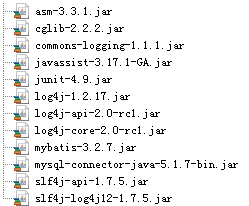入门:入门程序
跳到导航
跳到搜索
需求
- 根据用户id查询一个用户信息
- 根据用户名称模糊查询用户信息列表
- 添加用户
- 更新用户
- 删除用户
创建工程
依赖包
log4j.properties
在classpath下创建log4j.properties:
- mybatis默认使用log4j作为输出日志信息
# Global logging configuration
log4j.rootLogger=DEBUG, stdout
# Console output...
log4j.appender.stdout=org.apache.log4j.ConsoleAppender
log4j.appender.stdout.layout=org.apache.log4j.PatternLayout
log4j.appender.stdout.layout.ConversionPattern=%5p [%t] - %m%n
SqlMapConfig.xml
在classpath下创建SqlMapConfig.xml:
<?xml version="1.0" encoding="UTF-8" ?>
<!DOCTYPE configuration
PUBLIC "-//mybatis.org//DTD Config 3.0//EN"
"http://mybatis.org/dtd/mybatis-3-config.dtd">
<configuration>
<!-- 和spring整合后 environments配置将废除-->
<environments default="development">
<environment id="development">
<!-- 使用jdbc事务管理-->
<transactionManager type="JDBC" />
<!-- 数据库连接池-->
<dataSource type="POOLED">
<property name="driver" value="com.mysql.jdbc.Driver" />
<property name="url" value="jdbc:mysql://localhost:3306/mybatis?characterEncoding=utf-8" />
<property name="username" value="root" />
<property name="password" value="mysql" />
</dataSource>
</environment>
</environments>
</configuration>
po类
Po类作为mybatis进行sql映射使用,po类通常与数据库表对应。
User.java:
package cn.itcast.mybatis.po;
import java.util.Date;
public class User {
//属性名和数据库表的字段对应
private int id;
private String username;// 用户姓名
private String sex;// 性别
private Date birthday;// 生日
private String address;// 地址
public int getId() {
return id;
}
public void setId(int id) {
this.id = id;
}
public String getUsername() {
return username;
}
public void setUsername(String username) {
this.username = username;
}
public String getSex() {
return sex;
}
public void setSex(String sex) {
this.sex = sex;
}
public Date getBirthday() {
return birthday;
}
public void setBirthday(Date birthday) {
this.birthday = birthday;
}
public String getAddress() {
return address;
}
public void setAddress(String address) {
this.address = address;
}
@Override
public String toString() {
return "User [id=" + id + ", username=" + username + ", sex=" + sex
+ ", birthday=" + birthday + ", address=" + address + "]";
}
}
程序编写
查询
映射文件
在classpath下的sqlmap目录下创建sql映射文件Users.xml:
<?xml version="1.0" encoding="UTF-8" ?>
<!DOCTYPE mapper
PUBLIC "-//mybatis.org//DTD Mapper 3.0//EN"
"http://mybatis.org/dtd/mybatis-3-mapper.dtd">
<mapper namespace="test">
<!-- 根据id获取用户信息 -->
<select id="findUserById" parameterType="int" resultType="cn.itcast.mybatis.po.User">
select * from user where id = #{id}
</select>
<!-- 自定义条件查询用户列表 -->
<select id="findUserByUsername" parameterType="java.lang.String" resultType="cn.itcast.mybatis.po.User">
select * from user where username like '%${value}%'
</select>
</mapper>
加载映射文件
mybatis框架需要加载映射文件(在SqlMapConfig.xml中添加Users.xml),如下:
<?xml version="1.0" encoding="UTF-8" ?>
<!DOCTYPE configuration
PUBLIC "-//mybatis.org//DTD Config 3.0//EN"
"http://mybatis.org/dtd/mybatis-3-config.dtd">
<configuration>
...
<mappers>
<mapper resource="sqlmap/User.xml"/>
</mappers>
</configuration>
测试程序
public class Mybatis_first {
//会话工厂
private SqlSessionFactory sqlSessionFactory;
@Before
public void createSqlSessionFactory() throws IOException {
// mybatis配置文件
String resource = "SqlMapConfig.xml";
// 得到配置文件流
InputStream inputStream = Resources.getResourceAsStream(resource);
// 使用SqlSessionFactoryBuilder从xml配置文件中创建SqlSessionFactory
sqlSessionFactory = new SqlSessionFactoryBuilder().build(inputStream);
}
// 根据 id查询用户信息
@Test
public void testFindUserById() {
// 数据库会话实例
SqlSession sqlSession = null;
try {
// 创建数据库会话实例sqlSession
sqlSession = sqlSessionFactory.openSession();
// 查询单个记录,根据用户id查询用户信息
User user = sqlSession.selectOne("test.findUserById", 10);
// 输出用户信息
System.out.println(user);
} catch (Exception e) {
e.printStackTrace();
} finally {
if (sqlSession != null) {
sqlSession.close();
}
}
}
// 根据用户名称模糊查询用户信息
@Test
public void testFindUserByUsername() {
// 数据库会话实例
SqlSession sqlSession = null;
try {
// 创建数据库会话实例sqlSession
sqlSession = sqlSessionFactory.openSession();
// 查询单个记录,根据用户id查询用户信息
List<User> list = sqlSession.selectList("test.findUserByUsername", "张");
System.out.println(list.size());
} catch (Exception e) {
e.printStackTrace();
} finally {
if (sqlSession != null) {
sqlSession.close();
}
}
}
}
添加
映射文件
在Users.xml中添加:
<?xml version="1.0" encoding="UTF-8" ?>
<!DOCTYPE mapper
PUBLIC "-//mybatis.org//DTD Mapper 3.0//EN"
"http://mybatis.org/dtd/mybatis-3-mapper.dtd">
<mapper namespace="test">
...
<!-- 添加用户 -->
<insert id="insertUser" parameterType="cn.itcast.mybatis.po.User">
<!-- selectKey将主键返回,需要再返回 -->
<selectKey keyProperty="id" order="AFTER" resultType="java.lang.Integer">
select LAST_INSERT_ID()
</selectKey>
insert into user(username,birthday,sex,address) values(#{username},#{birthday},#{sex},#{address})
</insert>
</mapper>
测试程序
在Mybatis_first.java中添加:
public class Mybatis_first {
...
// 添加用户信息
@Test
public void testInsert() {
// 数据库会话实例
SqlSession sqlSession = null;
try {
// 创建数据库会话实例sqlSession
sqlSession = sqlSessionFactory.openSession();
// 添加用户信息
User user = new User();
user.setUsername("张小明");
user.setAddress("河南郑州");
user.setSex("1");
user.setPrice(1999.9f);
sqlSession.insert("test.insertUser", user);
//提交事务
sqlSession.commit();
} catch (Exception e) {
e.printStackTrace();
} finally {
if (sqlSession != null) {
sqlSession.close();
}
}
}
}
修改
映射文件
在Users.xml中添加:
<?xml version="1.0" encoding="UTF-8" ?>
<!DOCTYPE mapper
PUBLIC "-//mybatis.org//DTD Mapper 3.0//EN"
"http://mybatis.org/dtd/mybatis-3-mapper.dtd">
<mapper namespace="test">
...
<!-- 更新用户 -->
<update id="updateUser" parameterType="cn.itcast.mybatis.po.User">
update user set username=#{username},birthday=#{birthday},sex=#{sex},address=#{address}
where id=#{id}
</update>
</mapper>
测试程序
在Mybatis_first.java中添加:
public class Mybatis_first {
...
// 更新用户信息
@Test
public void testUpdate() {
// 数据库会话实例
SqlSession sqlSession = null;
try {
// 创建数据库会话实例sqlSession
sqlSession = sqlSessionFactory.openSession();
// 添加用户信息
User user = new User();
user.setId(16);
user.setUsername("张小明");
user.setAddress("河南郑州");
user.setSex("1");
user.setPrice(1999.9f);
sqlSession.update("test.updateUser", user);
// 提交事务
sqlSession.commit();
} catch (Exception e) {
e.printStackTrace();
} finally {
if (sqlSession != null) {
sqlSession.close();
}
}
}
}
删除
映射文件
在Users.xml中添加:
<?xml version="1.0" encoding="UTF-8" ?>
<!DOCTYPE mapper
PUBLIC "-//mybatis.org//DTD Mapper 3.0//EN"
"http://mybatis.org/dtd/mybatis-3-mapper.dtd">
<mapper namespace="test">
...
<!-- 删除用户 -->
<delete id="deleteUserById" parameterType="int">
delete from user where id=#{id}
</delete>
</mapper>
测试程序
在Mybatis_first.java中添加:
public class Mybatis_first {
...
// 根据id删除用户
@Test
public void testDelete() {
// 数据库会话实例
SqlSession sqlSession = null;
try {
// 创建数据库会话实例sqlSession
sqlSession = sqlSessionFactory.openSession();
// 删除用户
sqlSession.delete("test.deleteUserById",18);
// 提交事务
sqlSession.commit();
} catch (Exception e) {
e.printStackTrace();
} finally {
if (sqlSession != null) {
sqlSession.close();
}
}
}
}
入门小结
namespace
namespace命名空间,作用就是对sql进行分类化管理,理解sql隔离;
- 注意:使用mapper代理方法开发,namespace有特殊重要的作用
parameterType和resultType
- parameterType:指定输入参数类型,mybatis通过ognl从输入对象中获取参数值拼接在sql中。
- resultType:指定输出结果类型,mybatis将sql查询结果的一行记录数据映射为resultType指定类型的对象。
#{}和${}
- #{}:表示一个占位符号,通过#{}可以实现preparedStatement向占位符中设置值,自动进行java类型和jdbc类型转换;
- #{}可以接收简单类型值或pojo属性值。如果parameterType传输单个简单类型值,#{}括号中可以是value或其它名称。
- #{}可以有效防止sql注入。
- ${}:表示拼接sql串,通过${}可以将parameterType传入的内容拼接在sql中且不进行jdbc类型转换;
- ${}可以接收简单类型值或pojo属性值。如果parameterType传输单个简单类型值,${}括号中只能是value。
- 需要使用字段名而非字段值的情况下,应使用“${}”;
- 如,根据传入的字段名进行排序时:“
ORDER BY ${columnName}”
- 如,根据传入的字段名进行排序时:“
selectOne和selectList
- selectOne:查询一条记录,如果使用selectOne查询多条记录则抛出异常:
org.apache.ibatis.exceptions.TooManyResultsException: Expected one result (or null) to be returned by selectOne(), but found: 3 at org.apache.ibatis.session.defaults.DefaultSqlSession.selectOne(DefaultSqlSession.java:70)
- selectList:可以查询一条或多条记录。
mysql自增主键返回
通过修改sql映射文件,可以将mysql自增主键返回:
<!-- 添加用户 -->
<insert id="insertUser" parameterType="cn.itcast.mybatis.po.User">
<!-- selectKey将主键返回,需要再返回 -->
<selectKey keyProperty="id" order="AFTER" resultType="java.lang.Integer">
select LAST_INSERT_ID()
</selectKey>
insert into user(username,birthday,sex,address) values(#{username},#{birthday},#{sex},#{address})
</insert>
- selectKey:添加selectKey实现将主键返回
- keyProperty:返回的主键存储在pojo中的哪个属性
- order:selectKey的执行顺序,是相对与insert语句来说,由于mysql的自增原理执行完insert语句之后才将主键生成,所以这里selectKey的执行顺序为after
- resultType:返回的主键是什么类型
- LAST_INSERT_ID():是mysql的函数,返回auto_increment自增列新记录id值。
Mysql使用uuid实现主键
需要增加通过“select uuid()”得到uuid值:
<insert id="insertUser" parameterType="cn.itcast.mybatis.po.User">
<selectKey resultType="java.lang.String" order="BEFORE" keyProperty="id">
select uuid()
</selectKey>
insert into user(id,username,birthday,sex,address) values(#{id},#{username},#{birthday},#{sex},#{address})
</insert>
- 注意这里使用的order是“BEFORE”
Oracle使用sequence生成主键
首先自定义一个序列(SEQUENCE)且用于生成主键,selectKey使用如下:
<insert id="insertUser" parameterType="cn.itcast.mybatis.po.User">
<selectKey resultType="java.lang.Integer" order="BEFORE" keyProperty="id">
SELECT 自定义序列.NEXTVAL FROM DUAL
</selectKey>
insert into user(id,username,birthday,sex,address) values(#{id},#{username},#{birthday},#{sex},#{address})
</insert>
- 注意这里使用的order是“BEFORE”
关于Bean管理
未整合到spring时,SqlSessionFactory不能交给spring管理,需要自己操作:
public class Mybatis_first {
//会话工厂
private SqlSessionFactory sqlSessionFactory;
@Before
public void createSqlSessionFactory() throws IOException {
// mybatis配置文件
String resource = "SqlMapConfig.xml";
// 得到配置文件流
InputStream inputStream = Resources.getResourceAsStream(resource);
// 使用SqlSessionFactoryBuilder从xml配置文件中创建SqlSessionFactory
sqlSessionFactory = new SqlSessionFactoryBuilder().build(inputStream);
}
public void testFindUserById() {
// 数据库会话实例
SqlSession sqlSession = null;
try {
// 创建数据库会话实例sqlSession
sqlSession = sqlSessionFactory.openSession();
// SqlSession中封装了对数据库的操作,如:查询、插入、更新、删除等
// selectOne
User user = sqlSession.selectOne("test.findUserById", 10);
// selectList
List<User> list = sqlSession.selectList("test.findUserByUsername", "张");
// insert
sqlSession.insert("test.insertUser", user);
// update
sqlSession.update("test.updateUser", user);
// delete
sqlSession.delete("test.deleteUserById",18);
...
} catch (Exception e) {
e.printStackTrace();
} finally {
if (sqlSession != null) {
sqlSession.close();
}
}
}
}
